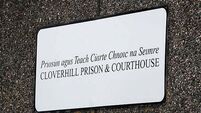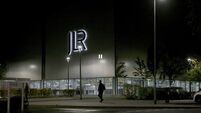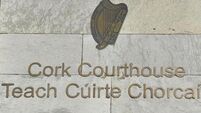Irish cinema on the cusp of something special

Despite the economic restrictions of the recession, an increase of artistic activity and new projects delivered the industry one of its most rewarding periods of modern times.
This resurgence was underlined by Time magazine last year, naming two Irish films among its Top 10 for 2016 — John Carney’s homage to 1980s Dublin, Sing Street, and the futuristic dystopian tale, The Lobster, starring Colin Farrell, filmed in Kerry and Dublin.
The influential magazine capped its praise of the Irish industry by putting actress Saoirse Ronan on the cover, profiling her as one of the Next Generation Leaders who are “ready to take over their fields”.
Hollywood film industry bible, Variety, also weighed in with similar glowing sentiments, saying Ireland’s creative resurgence was benefiting not only the local film industry, but also world cinema at large.
The 2016 Oscars were a watershed moment for the industry, with Lenny Abrahamson’s Room and John Crowley’s Brooklyn receiving Best Picture nominations.
Abrahamson and Saoirse Ronan were also nominated in the Best Director and Best Actress categories, while Paddy Breathnach’s Viva was among the finalists in the ultimate selection for Best Foreign Film.
Irish film also has a number of important nods for the Golden Globes.
Ruth Negga and Colin Farrell lead the Irish nominations, in the Best Actress category for her role in Loving, while the Dubliner gets the Best Performance nod in the Best Actor category for The Lobster.
John Carney’s Sing Street is also nominated for Best Comedy/Musical. Adding to this invaluable publicity, two Irish titles will also screen as part of the World Cinema Documentary Competition at the upcoming Sundance Film Festival, running from January 19 to 29 in Utah.
Frankie Fenton’s It’s Not Yet Dark examines the life of fellow Irish director Simon Fitzmaurice, diagnosed with motor neurone disease in 2008, and who wrote and directed My Name is Emily last year, using only his eyes.
The project is narrated by Colin Farrell and produced by Kathryn Kennedy of Kennedy Films and Lesley McKimm, formerly of Newgrange Pictures.
The second film, In Loco Parentis, directed by David Rane and Neasa Ní Chianáin explores the world of Headfort School, the only remaining boarding school for primary age children in Ireland.
It recently screened at the International Documentary Film Festival in Amsterdam, the only Irish title ever to be selected for the festival. Seven Irish films were selected for last year’s Sundance, the most for any nation outside of the US.
“As the largest independent film festival in the US, the Sundance Film Festival provides an important and powerful platform for both Irish films to achieve global recognition,” said James Hickey, chief executive of the Irish Film Board.
He added: “The importance of being selected ahead of thousands of other films for major festivals such as Sundance cannot be underestimated in terms of ensuring wide international audiences.”
Capping off a significant 2016 for the industry, writer-director Peter Foott’s comedy-drama, The Young Offenders, filmed around Cork, passed the €1m mark at the Irish box — the fastest Irish film to break this milestone.
The Irish Film Board finished 2016 on a high with the announcement of an extra €1.1m in government funding — bringing to €15.5m the total provided for 2017.
Meanwhile, a five-year government initiative promoting access to cultural and creative activity from 2017 to 2022 was unveiled last month.
The initiative is part of a long-term strategy to develop Ireland as a hub for film, television, drama and animation, in support of artists and investment in our cultural institutions, while cultivating Ireland’s reputation internationally.
Mr Hickey said: “This programme will present in developing young Irish writers, directors, actors and crew to contribute to Ireland’s cultural life, telling Irish stories which are an important part of Irish identity. We look forward to working with our partner agencies to further develop opportunities in this area, creating more jobs and strengthening Ireland’s reputation as a centre of excellence.”
Minster for Arts, Heather Humphreys, added: “We want to make Ireland a global hub for film and TV production, while also investing in our cultural institutions.”
Key initiatives to be delivered in 2017 include the publication of a five year ‘Creative Children’ plan which will enable every child to access tuition in music, drama, art and coding.
Each local authority will appoint a Culture Team to drive local needs and will publish a Culture Plan for their own county. A new annual cultural day, ‘Cruinniú na Cásca’, to be held nationwide on Easter Monday each year.
Added to these positive developments is Troy Studios in Limerick, Ireland’s largest film studio, which opened its doors for the first time last November, comprising 350,000 square feet under one roof of sound stages, support infrastructure and a five-acre backlot.
The former Dell factory at Plassey Technological Park, adjacent to the University of Limerick, is double the size of Ardmore Studios, and arrives at a time when the industry is in immediate need of additional space.
James Flynn, managing director of Octagon Films, and producer of The Vikings, The Tudors and Penny Dreadful, said: “It’s going to be very attractive for American productions coming to Ireland. We have probably missed out on a lot of feature films to the UK in the past, but Ireland is definitely now one of the top go-to locations in terms of attractiveness.
"More studio space is needed to maximise these tax incentives. A lot more space is needed in order to cope with the high volume of demand that is hopefully going to come our way.”
The audio visual content production sector in Ireland is estimated to be worth in excess €550 million, employing over 6,000, with over 560 SMEs operating in the sector.
The film industry’s knock-on effect on the tourism sector is underlined by a previous survey which revealing 20% of all tourists cited film as an influencing factor on why they visited Ireland.
The Section 481 programme, which has been increased to up to 32% of eligible Irish expenditure, continues to be a key element of attractive outside productions to the country.
Screen Producers Ireland CEO Barbara Galavan said: “This was clearly a factor in the decision to launch Pinewood Productions Ireland. This initiative by a major international studio facility to establish a footprint in Ireland is testament to the professional production industry and creative talent pool that is available here.”
The Pinewood Group operates studios across the UK and around the world. Productions filmed at their facilities include the James Bond series, the Harry Potter franchise, The Dark Knight, Les Misérables and Avengers: Age of Ultron.
In an associated development, Liam Neeson has given his support for plans to build a €75m film studio on Dublin’s Poolbeg Peninsula. The 200,000 sq. ft.
Dublin Bay Studios would employ up to 1,800, and exceed the combined size of available studio space at Ardmore, Ashford and Troy Studios on a 20-acre site — the “missing piece of the jigsaw”, according to actor Cillian Murphy.

















